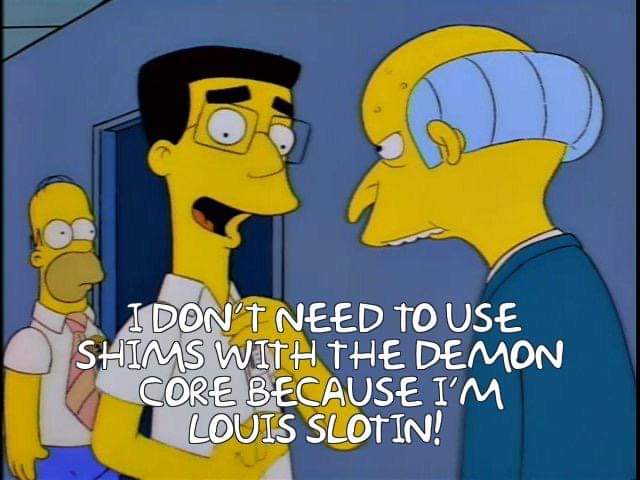I’ve previous heard of Slotin’s death by unexpected criticality, but I was not previously aware of how much his failure to follow procedure, or operate with a grain of common sense, contributed to his death and the serious illness of his co-workers.
—-
https://en.m.wikipedia.org/wiki/Louis_Slotin
On 21 May 1946, with seven colleagues watching, Slotin performed an experiment that involved the creation of one of the first steps of a fission reaction by placing two half-spheres of beryllium (a neutron reflector) around a 3.5-inch-diameter (89 mm) plutonium core. The experiment used the same 6.2-kilogram (13.7 lb) plutonium core that had irradiated Daghlian, later called the “demon core” for its role in the two accidents. Slotin grasped the upper 228.6 mm (9-inch) beryllium hemisphere with his left hand through a thumb hole at the top while he maintained the separation of the half-spheres using the blade of a screwdriver with his right hand, having removed the shims normally used. Using a screwdriver was not a normal part of the experimental protocol.
At 3:20 p.m., the screwdriver slipped and the upper beryllium hemisphere fell, causing a “prompt critical” reaction and a burst of hard radiation. At the time, the scientists in the room observed the blue glow of air ionization and felt a heat wave. Slotin experienced a sour taste in his mouth and an intense burning sensation in his left hand. He jerked his left hand upward, lifting the upper beryllium hemisphere, and dropped it to the floor, ending the reaction. He had already been exposed to a lethal dose of neutron radiation. At the time of the accident, dosimetry badges were in a locked box about 100 feet (30 m) from where the reaction occurred. Realizing that no one in the room had their film badges on, “immediately after the accident Dr. Slotin asked Dr. Raemer E. Schreiber to have the badges taken from the lead box and placed on the critical assembly”. This peculiar response was of no value for determining the actual doses received by the men in the room and put Schreiber at “great personal risk” of additional exposure. A report later concluded that a heavy dose of radiation may produce vertigo and can leave a person “in no condition for rational behavior.” As soon as Slotin left the building he vomited, a common reaction from exposure to extremely intense ionizing radiation. Slotin’s colleagues rushed him to the hospital, but the radiation damage was irreversible.
The seven other men present at the time of the reaction included Alvin Cushman Graves, Samuel Allan Kline, Marion Edward Cieslicki, Dwight Smith Young, Theodore P. Perlman, and Pvt. Patrick J. Cleary. By 25 May 1946, four of these seven men had been discharged from hospital. The United States Army physician responsible for the Los Alamos base hospital, Captain Paul Hageman, said that Slotin’s, Graves’, Kline’s and Young’s “immediate condition is satisfactory.”
Despite intensive medical care and offers from numerous volunteers to donate blood for transfusions, Slotin’s condition was incurable. He called his parents and they were flown at Army expense from Winnipeg to be with him. They arrived on the fourth day after the incident, and by the fifth day his condition started to deteriorate rapidly.
Over the next four days, Slotin suffered an “agonizing sequence of radiation-induced traumas”, including severe diarrhea, reduced urine output, swollen hands, erythema, “massive blisters on his hands and forearms”, intestinal paralysis and gangrene. He had internal radiation burns throughout his body, which one medical expert described as a “three-dimensional sunburn.” By the seventh day, he was experiencing periods of “mental confusion.” His lips turned blue and he was put in an oxygen tent. He ultimately experienced “a total disintegration of bodily functions” and slipped into a coma. Slotin died at 11 a.m. on 30 May, in the presence of his parents. He was buried in the Shaarey Zedek Cemetery in Winnipeg on 2 June 1946.
Other injuries and death
Edit
Graves, Kline and Young remained hospitalized after Slotin’s death. Graves, who was standing the closest to Slotin, also developed acute radiation sickness and was hospitalized for several weeks. He survived, although he lived with chronic neurological and vision problems. Young also suffered from acute radiation syndrome, but recovered. By 28 January 1948 Graves, Kline and Perlman sought compensation for damages suffered during the incident. Graves settled his claim for $3,500.Three of the observers eventually died of conditions that are known to be promoted by radiation: Graves of a heart attack twenty years later at age 55; Cieslicki of acute myeloid leukemia nineteen years later at age 42; and Young of aplastic anemia and bacterial infection of the heart lining twenty-nine years later at age 83. Some of the deaths may have been a consequence of the incident. Louis Hempelman, M.D., a consultant to the Los Alamos Scientific Laboratory, believed that it is not possible to establish a causal relation between the incident and the specifics of the death from such a small sample. He stated this opinion in a publicly available report that included personal medical information which he had previously declined to release to Marion E. Cieslicki during the final stages of his illness.
___
Can’t say he was unaware of the risks because one of his lab assistant’s, Harry Daghlian, had died in a brief criticality mishap a few months beforehand.

